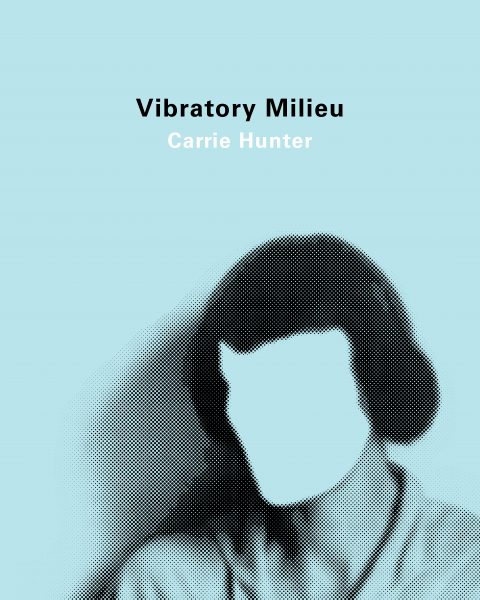
Today on the Nightboat blog, the poet Carrie Hunter discusses the writing and process behind her book Vibratory Milieu, taking us along with her as she details her experience writing poems in the back of a credit union, her belief in the “sense” of disjunction, and the politics of her collage poetics. Read on below!
Vibratory Milieu was written over a span of eight years (around 2010-2017 or so) using bits and pieces from a multitude of sources: current events, social media (from the era when we used Facebook to write contextless poetic lines), lines from or inspired by films, and, of course, literature and theory. I also took lines from my journals and dream journals; as well as several abandoned projects, such as poems written to music, poems written after meditation, and poems written in response to poems by friends. I also took lines from an unfinished trilogy Tumblr blog I’d been keeping early on (scroll way down) that was itself a collage poem engaging mainly with Dante, as well as using notes from yoga references and yoga philosophy, dreams, and classes on linguistics and language learning. This blog was also where Robert Duncan’s H.D. Book references come from.
A precursor to Vibratory Milieu, and probably the beginning of the collage style, came about when I worked in the back office of a credit union and was so busy that I didn’t have time to write. Then Suzanne Stein (credit due) told me I have to find a way to write, so I started writing one line an hour, on the hour, every day. This became my Dusie chapbook, The Unicorns, and was when I discovered that writing lines that happened temporally far apart from each other creates a great disjunction because one is inevitably thinking about different things an hour later.
People have sometimes asked me about this contextless collage style I do, and wonder how I do it, and what led to this style. It was obviously adapted from cut-up traditions and Language poetry’s “the sentence,” but it also came out of my thesis advisor telling me that my MFA thesis was very repetitive—so I started cutting out a lot. Despite his problematics (both of them), I learned a lot from Tom Clark’s class on Pound’s The Cantos about editing: write a lot, just incessantly, but then also cut out a lot, too.
Years ago, someone at a reading asked me who my influences are, and I said H.D. and Lyn Hejinian. He said he could understand the Hejinian, as I’m obviously influenced by Language poetry, but asked me about H.D., which seemed less obvious. I remember when I first came across her at a college library and I just swooned reading “The Islands.” The lyricism as well as the repetition; the incantatory repetition. Later on, I was moved by reading about her vision at Corfu, and her “jellyfish experience” in Notes on Thought and Vision. I’ve always loved the lyrical and the mystical, as well as the abstract and the cerebral.
I’ve continued writing in this form because of a love of “the project.” Using collaged pieces within a project format seems, to me, to create a sense of a cohesive whole. I always thought that although sentence by sentence, finding meaning or a thesis to my poems would not be so obvious, situating collage within a project arc leads, hopefully, to an accretion of meaning through the stacked-up fragments.
I don’t think a poet needs to make sense of temporal disjunction. Temporal disjunction is what makes sense! Sound and image play a part in this in that they are also “parts” of the disjunction. Sound is part of poetry since that was the beginning of poetry. And image, perhaps image of the dream, images from film, are also parts of the disjunction, just as true collage (visual art) uses them. What makes disjunct(ive) lines a poem is that it’s a restructuring of what is. I’ve always thought that if I wanted reality as it is, I could just walk outside! I’m more interested in possibility, new configurations, new ways of seeing.
If the collage form has a politics, it could easily be about the postmodern, fractured condition. For me, the form may really be about my years-long habit of dissociation due to my childhood, about never being all there. This is very personal, but early on I experienced multiple family members trying to exert control through monologuing and demanding full attention for long periods of time, and I would fake listening, so of course, as that became a habit, it became a problem also, but it also became something I could use. And how many of us are ever really all there, especially in today’s age of “continuous partial attention”? The collage form could also be a refusal to be there, in capitalism, under patriarchy, a turning away from all the details, and from the monologuers.
